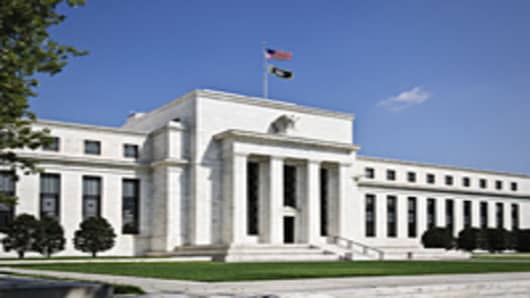If you looked over the past several years to the Federal Reserve for projections about where the economy was headed, chances are pretty good you got bum information.
The US central bank, in fact, has had an abysmal track record over the preceding three years or so when alerting investors about the direction of unemployment and gross domestic product in particular.
Projected gains in the economy instead ended up as drops; an expected sharp decrease in unemployment never materialized and in fact turned out to be just the opposite; inflation forecasts may have been a little more accurate, but it may have been just a lucky guess more than a grasp of price direction.
As the Fed tries to steer the economic recovery, there are questions over how well Chairman Ben Bernanke and the rest of the Fed governors understand what is coming in the years ahead. The Fed on Wednesday released a forecast that said the economy was improving incrementally but not enough to change rate policy.
"Essentially the Fed's visibility into the US economy during difficult economic times is close to zero," Nicholas Colas, chief investment strategist at BNY ConvergEx in New York, wrote in a narrative accompanying research he has performed on the central banks' forecasting prowess.
"Compared side-by-side with actual outcomes, the numbers speak for themselves," he added. "Needless to say, we don't intend to make any personal investment decisions based on Wednesday's 2011, 2012 and 2013 forecasts."
A few examples of recent big misses in Fed forecasts:
- In June 2007, it predicted a 2.6 percent increase in real GDP for 2008, against the actual number of minus-2.8 percent. Two years later, the Fed predicted in the second quarter of 2009 a minus-1.7 percent reading for GDP for the next year when it actually came in at 0.2 percent.
- For 2008, the Fed predicted inflation in a gaping range of 2 to 4 percent, but the actual rate of 1.7 percent was outside even that wide set of parameters.
- In October 2007, the Fed expected unemployment to hit 4.9 percent in 2008 and stay flat through 2010, ticking down to 4.8 percent. Even a raising of the projection in October 2008 all the way up to 7.4 percent still managed to miss the actual outcome of a peak at 10.1 percent in 2010.
To be sure, the Fed hasn't been in the dark the whole way: The numbers show that the farther out the forecast, the more glaring the error.
That's why some economists believe it's unfair to paint the Fed's mistakes with too broad a brush.
"They missed the call on unemployment, there's no question about that," said Peter Cardillo, chief economist at Avalon Partners in New York. "You have to realize that we experienced a recession that was over and beyond what they were looking at. We had a credit crunch. We didn't just have a normal decline in the housing market...we actually had a depression in the housing sector.
"So it became rather difficult for the Fed to get a real grip on the outcome, and that's the reason they resorted to a lot of stimulus for the economy."
Colas noted that most economists, in fact, missed how bad the recession was going to be.
"But isn't that precisely when accurate forecasting is most important?" he wrote. "During periods of stability, getting projections right isn't much of a challenge. But nor is it especially useful.
"You don't need a compass on a clear day with land in sight. But when you are out in stormy weather and the reef is approaching, getting the navigation right is the only thing that matters."
The Fed's ability to provide reliable forecasts is important as the central bank continues its monetary easing programsand ultimately tries to unwind the more than $2.5 trillion in balance sheet expansion over the past three years.
In trying to steady the financial system, the Fed has enacted an ambitious quantitative easing program to buy Treasurys and other debt in an effort to inject money and growth into the economy. The easing programs have resulted in soaring prices in the stock and commodities markets.
But if the Fed is failing to foresee long-term trends in the economy, that heightens the risk of a policy mistake that could create runaway inflation or short-circuit the recovery.
"I wouldn't trust the Fed to tell me what the weather is doing in the next 10 minutes even if they were looking out the window," said Michael Pento, a Fed critic and senior economist at Euro Pacific Capital in New York. "Their predictive powers are set by agendas, they're set by certain proclivities. Clearly, they're woefully inadequate in terms of predicting GDP, inflation and anything else economically."
The problems with foreseeing economic trends feed into another debate—whether the Fed should have a dual mandateof controlling employment and inflation, or should focus only on price stability.
Congressional Republicans have been pushing for a single mandate, and the issue is likely to come up in the months ahead as the new GOP-controlled House pushes its agenda forward.
"I used to think that revising the famous Fed 'dual mandate' was a mistake—a needless politicization of monetary policy," Colas said. "But the data here points to a different conclusion. Asking the Fed to manage policy around a metric they have no ability to forecast is essentially a 'Rambo mission': set up to fail."



